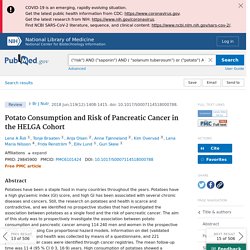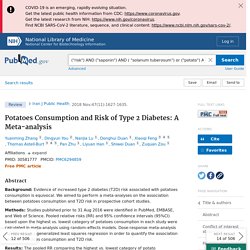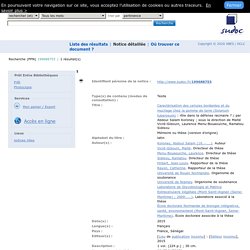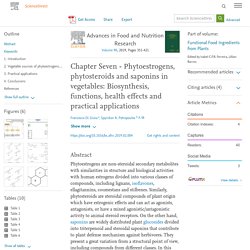

Changes in Diet and Lifestyle and Long-Term Weight Gain in Women and Men - PubMed. Background: Specific dietary and other lifestyle behaviors may affect the success of the straightforward-sounding strategy "eat less and exercise more" for preventing long-term weight gain.

Methods: We performed prospective investigations involving three separate cohorts that included 120,877 U.S. women and men who were free of chronic diseases and not obese at baseline, with follow-up periods from 1986 to 2006, 1991 to 2003, and 1986 to 2006. The relationships between changes in lifestyle factors and weight change were evaluated at 4-year intervals, with multivariable adjustments made for age, baseline body-mass index for each period, and all lifestyle factors simultaneously.
Potato Consumption and Risk of Pancreatic Cancer in the HELGA Cohort - PubMed. Potatoes have been a staple food in many countries throughout the years.

Potatoes have a high glycaemic index (GI) score, and high GI has been associated with several chronic diseases and cancers. Still, the research on potatoes and health is scarce and contradictive, and we identified no prospective studies that had investigated the association between potatoes as a single food and the risk of pancreatic cancer. The aim of this study was to prospectively investigate the association between potato consumption and pancreatic cancer among 114 240 men and women in the prospective HELGA cohort, using Cox proportional hazard models. Information on diet (validated FFQ's), lifestyle and health was collected by means of a questionnaire, and 221 pancreatic cancer cases were identified through cancer registries.
The mean follow-up time was 11·4 (95 % CI 0·3, 16·9) years. Potato Consumption and Risk of Pancreatic Cancer in the HELGA Cohort - PubMed. Potatoes Consumption and Risk of Type 2 Diabetes: A Meta-analysis - PubMed. Background: Evidence of increased type 2 diabetes (T2D) risk associated with potatoes consumption is equivocal.

We aimed to perform a meta-analyses on the association between potatoes consumption and T2D risk in prospective cohort studies. Methods: Studies published prior to 31 Aug 2016 were identified in PubMed, EMBASE, and Web of Science. Pooled relative risks (RR) and 95% confidence intervals (95%CI) based upon the highest vs. lowest category of potatoes consumption in each study were calculated in meta-analysis using random-effects models.
Dose-response meta-analysis was fitted using generalized least squares regression in order to quantify the association between potatoes consumption and T2D risk. Results: The pooled RR comparing the highest vs. lowest category of potato consumption was 1.077 (95%CI: 1.005, 1.155). Keywords: French fries; Potatoes; Type 2 diabetes. Catalogue SUDOC. Nous avons exploré la diversité génétique du complexe d'espèces Ralstonia solanacearum (ceRs) pour caractériser et comprendre les graves épidémies de flétrissement bactérien qui sévissent à Madagascar.

Une large collection de souches (n=1224; 75 sites) est constituée. Les souches sont assignées aux phylotypes I, III, et la grande majorité associée à l'épidémie appartiennent au groupe IIB-1 (‘Brown rot’ des anglo-saxons) signalé pour la première fois à Madagascar. L'approche MLVA (RS2-MLVA9) a révélé leur apparenté aux souches IIB-1 distribuées mondialement, suggérant ainsi une introduction malheureuse à Madagascar.
Trois populations clonales se propagent par des tubercules infectées. Le génotypage des souches du phylotype III, avec le schéma hautement résolutif RS3-MLVA16 que nous avons développé, a révélé une forte diversité génétique structurée géographiquement en onze populations clonales bien différenciées. Catalogue SUDOC. Catalogue SUDOC. La pomme de terre (Solanum tuberosum) représente la principale denrée alimentaire non céréalière et a été déclarée comme « aliment du futur » en 2008 par la FAO.

De nos jours, la production mondiale de la pomme de terre a atteint 374 million de tonnes (FAO). Cependant la pomme de terre est sensible à de nombreuses maladies racinaires comme la maladie de la jambe noire causée par Erwinia carotovora subsp. Atroseptica (Latour et al., 2008). A ce jour, il n'existe aucun traitement chimique ou biologique efficace pour lutter contre ces pathogènes telluriques. Ainsi, une meilleure compréhension des mécanismes physiologiques, cellulaires et moléculaires impliqués dans les interactions racines/pathogènes s'avère nécessaire pour proposer de nouvelles stratégies de défense contre ces pathogènes. Potato consumption is prospectively associated with risk of hypertension: An 11.3-year longitudinal cohort study.
The Association of Potato Intake With Risk for Incident Type 2 Diabetes in Adults. Objectifs Des études antérieures indiquent que le risque de diabète associé à une consommation élevée de pomme de terre diffère selon les populations.

Nous avons cherché à étudier les associations entre l'ingestion de pommes de terre sous forme bouillie, frite ou totale et le risque d'incidence de diabète chez les adultes téhéranais. Méthodes Cette étude de cohorte a été menée chez 1 981 adultes, âgés de 19 à 70 ans, qui ont participé à l'Etude sur les Lipides et le Glucose de Téhéran et ont été suivis pendant 6 ans. Les apports habituels en pommes de terre alimentaires ont été évalués à l'aide d'un questionnaire valide et fiable sur la fréquence alimentaire. Résultats L'âge moyen±Ecart Type et la consommation de pommes de terre chez les participants étaient de 38,9±13,4 ans et de 30,2±30,7 g/jour, respectivement.
Conclusions. Potato consumption, by preparation method and meal quality, with blood pressure and body mass index: The INTERMAP study. Phytoestrogens, phytosteroids and saponins in vegetables: Biosynthesis, functions, health effects and practical applications. Outline AbstractKeywords1.

Introduction2. Vegetable sources of phytoestrogens, phytosteroids and saponins3. Practical applications4. ConclusionsReferences Tables (10) Table 1Table 2Table 3Table 4Table 5Table 6 Abstract Phytoestrogens are non-steroidal secondary metabolites with similarities in structure and biological activities with human estrogens divided into various classes of compounds, including lignans, isoflavones, ellagitannins, coumestans and stilbenes. Keywords Brassinosteroids Brassinolide Coumestans Ecdysteroids Ellagitannins Isoflavones Lignans. Saponins in Madhuca Longifolia as undesirable substances in animal. Scientific opinion on safeguard clause invoked by Hungary on GM. NUT2007sa0095Ra. Presentation lipides pommes de terre.